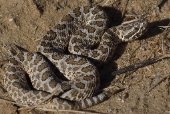Western Massasauga (Sistrurus tergeminus)
Description: This is a small rattlesnake that measures 17 to 39 1/2 inches in length. There is a row of black or dark brown mid dorsal blotches on a lighter brown or gray background. There are two or three rows of small spots on the sides. All blotches and spots may be outlined in white. The blotches usually turn into rings on the tail. It has an overall more gray dusky or smoky appearance than the eastern massasauga. There is a rather broad dark stripe from the eye past the angle of the jaw. The belly is mostly black with irregular white or yellowish marks.
Western massasaugas are stout bodied snakes with a triangular shaped head. The pupils are vertically elliptical and there is a heat sensitive pit located between the eye and nostril. This pit is larger and positioned lower on the face than the nostril. There is a rattle at the end of the tail. The rattle is comprised of a series of interlocking keratinous segments that make a buzzing noise when the tail is vibrated. The scales are keeled and the anal plate is single.
Habitat: in the more desert regions the habitat is shortgrass prairie habitat with >40% cover with abundant sand sage, buffalograss, and blue grama grass, below 5,500 ft/1,500 m elevation. They summer in open arid shortgrass, mixed grass/sandsage prairie and occasionally sand dune habitat with loose sandy soils and move to adjacent hardpan short-grass habitat in the fall to hibernate.
When found in eastward it is more mesic grasslands, including tallgrass prairie with nearby wetlands or drainages. They tend to occur in areas of dense grass or for cover and moderate amounts of leaf litter during the summer and fall. Lowland prairie habitats containing loose, loamy soils with many small mammal burrows and sparse vegetation in winter. Often uses crayfish burrows to hibernate.
Range: It is found in the United States in the southwestern plains from southeastern Colorado to extreme southeastern Nebraska and northwestern Missouri, southwest through east-central Kansas and west-central Oklahoma into northern and central Texas about as far southwest as the Colorado River. It is also found in Mexico, in the states of Tamaulipas, southern Nuevo León, north-central Coahuila, and Samalayuca, Chihuahua. The type locality given is "between the Mississippi River and the Rocky Mountains".
Venom: Drop for drop, massasauga venom is more potent than that of many larger species of rattlesnakes, but due to the lower yield (the amount it is capable of delivering in a single bite), its potential for harm is greatly reduced. The venom is a powerful hemotoxin which can cause swelling, necrosis, and severe pain. Despite its smaller size and less severe bite, envenomation can still be fatal if untreated, and treatment should be sought immediately for any venomous snake bite. The antivenin CroFab, while not type-specific, can be used to treat severe envenomations from massasaugas.
Diet: The diet of western massasaugas is comprised largely of small mammals, but small birds, lizards, frogs, toads, and other snakes are also consumed. While adults usually feed upon rodents, small snakes are an important food item for young massasaugas. It is interesting to note that this snake will bite and release adult rodents then search them out and swallow them after they are dead. When birds, lizards, or snakes are to be consumed, they are held in the snake’s jaws until the venom takes effect or are eaten immediatel
Reproduction: They breed in the spring and fall. They may only breed every other year or less and are sexually mature at the age of three or four. They give birth to living young (ovoviviparous). The young number from 5 to 24 and are about 5 to 7 inches in length. The young are equipped with fangs and are venomous as soon as they are born.
Status: It is listed as Critically Imperiled in Arizona, Iowa, & Nebraska. Listed as Imperiled in Colorado. Listed as Vulnerable in Kansas, New Mexico, & Texas. Oklahoma and Missouri have it listed as SNR (NO Status Rank).
»» Kingdom: Animalia - Animals
»» Phylum: Chordata - Chordates
»» Subphylum: Vertebrata - Vertebrates
»» Class: Reptilia - Reptiles
»» Order: Squamata - Scaled Reptiles
»» Suborder: Serpentes
»» Clade: Colubroides
»» Family: Viperidae - Vipers
»» Genus: Sistrurus
»» Species: Sistrurus tergeminus - Western Massasauga
This article uses material from the Wikipedia article "Sistrurus tergeminus", which is released under the Creative Commons Attribution-Share-Alike License 3.0. Content may have been omitted from the original, but no content has been changed or extended.
|














